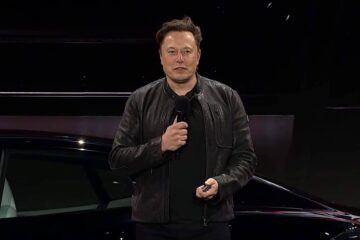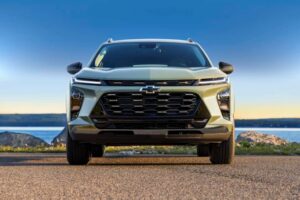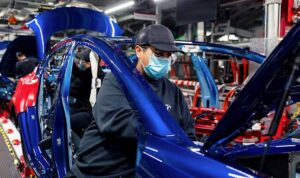French automaker Peugeot, part of the Stellantis corporate structure, unveiled the Inception concept vehicle at the 2023 Consumer Electronics Show last week in Las Vegas.
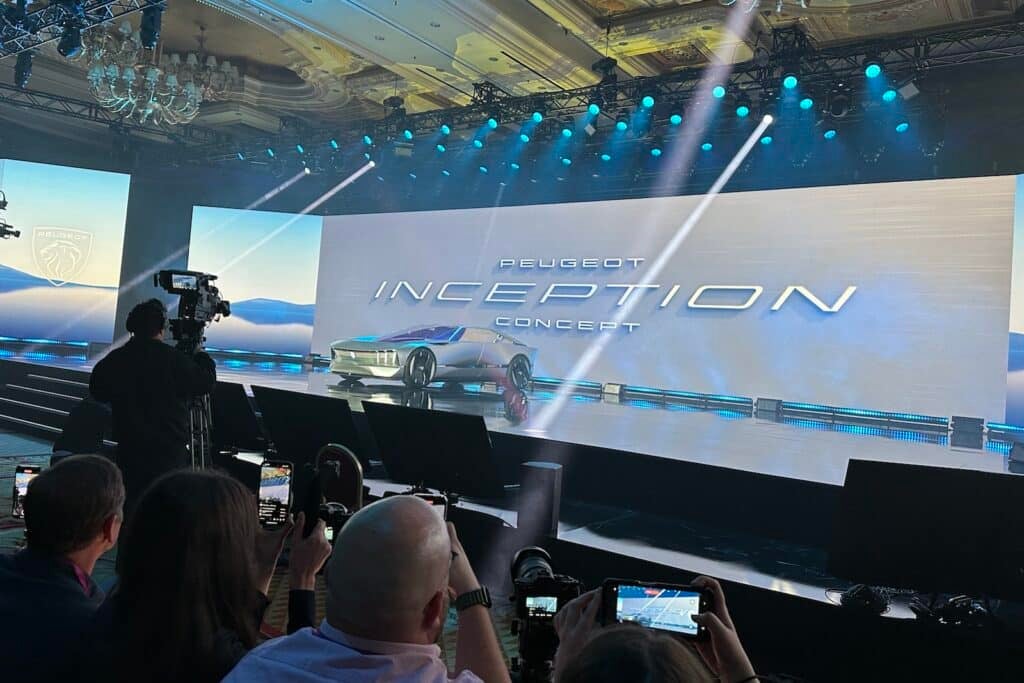
Previously shown at the 2022 Paris Motor Show last October, Peugeot says the concept explores possibilities in the brand’s “BEV-by-design” next-generation electric platform. According to the company, the Inception maintains certain key Peugeot features including a feline stance and three-claw highlights.
“With a firmly optimistic vision of the future of automotive, the Peugeot Inception Concept will embody the brand’s core values — allure, emotion and excellence,” the brand said in a release.
The BEV-by-design trend is making its way though the industry as more and more automakers make the shift toward battery-electric products.
“Peugeot is committed to the electrification of its range,” said Linda Jackson, CEO of Peugeot, at the unveiling. “In 2023, 100% of the vehicles in the range will be electrified and in the next two years, five new 100% electric models will be launched.”
“Our ambition is simple: to make Peugeot the leading electric brand in Europe by 2030,” Jackson continued. “This objective and ambitious vision pave the way for a radical transformation for the brand. It is embodied today in the Peugeot Inception concept, which marks the beginning of a new era.”
Peugeot said the Inception concept car gives consumers “a taste of the next generation of models and … the features and technology that customers will find in their future Peugeot.”
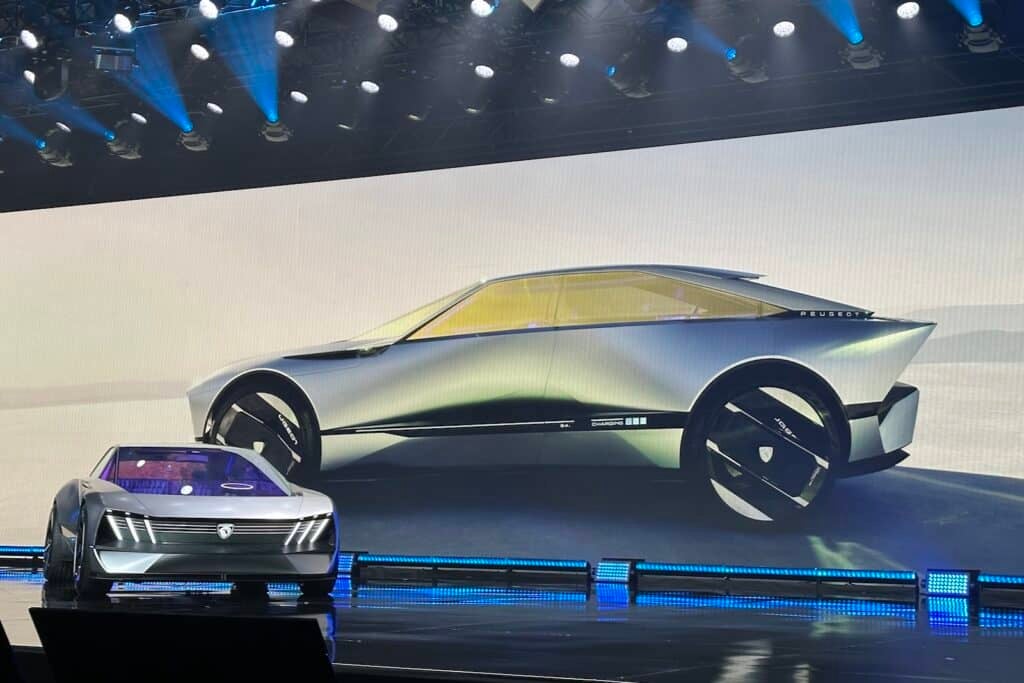
New design
The Inception concept is the first expression of a new Peugeot Design Manifesto led by Peugeot design director Matthias Hossann.
“Peugeot is changing, but the Peugeot Inception concept remains unmistakably a Peugeot,” Hossann said. “The Inception reinvents the spatial experience of driving while illustrating some of our thinking behind reducing Peugeot’s carbon footprint by more than 50% by 2030. The transformation of the brand concerns all aspects of the design, production, and life of tomorrow’s Peugeot.”
The Inception concept is built on one of the four future Stellantis “BEV-by-design” platforms, scheduled to hit the market starting in 2023. The STLA Large platform on which the Peugeot Inception concept is based offers a sedan profile with a roof height of about 53 inches and an overall length about 197 inches. Peugeot’s designers chose this size to highlight the design features of the concept, including the flowing curves of the bodywork, and the interactive display belt around the car.
New Tech
The Inception concept is equipped with an 800-volt drive system. A 100-kWh battery enables a 500-mile range with energy use measured at 12.5 kWh over 62 miles. The concept includes support for wireless induction charging, much like a wireless phone charger.
Power comes from two compact electric motors mounted at the front and rear in the standard EV AWD configuration. Combined power is close to 680 hp, with 0-62 acceleration in less than 3 seconds.
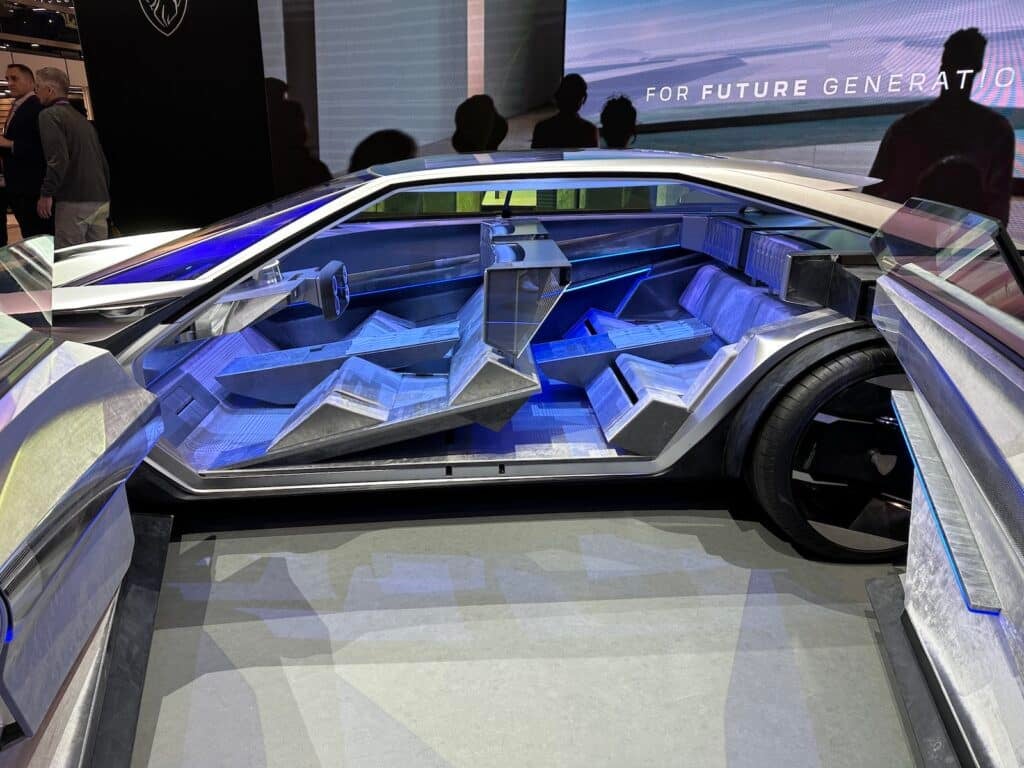
“Peugeot’s transformation goes far beyond the sole ambition of becoming 100% electric,” said Peugeot product director Jérôme Micheron. “The brand will allow you to take full advantage of all the new possibilities offered by electric technology and new software to live new and enriching experiences.”
One of those experiences is a “tech bar” that runs horizontally along the exterior of the doors. The bar is a screen that displays different messages to the outside of the car when the driver and passengers approach the vehicle. The car will recognize the driver and set up the comfort settings specified by each occupant, displaying the vehicle’s charge level as well as welcome or goodbye messages.
“Like the Peugeot Inception concept, our future models will be equipped with STLA Brain artificial intelligence and will be fully connected,” said Peugeot Marketing and Communications Director Phil York. “Customers will enjoy a seamless experience, combining physical and human interaction, virtual discussions with the brand, and intelligent online services.”
Interior meant for napping
The Inception concept offers a new vision of a vehicle interior with laid back and elongated seating positions. The seats are said to feature adjustable cushioning around the shoulders.
“All seat proportions have been reworked, with more width and immersive comfort,” the company notes in the release, “with a seat that adapts to the body shape of each passenger. The architecture and apparent structure of the seat are adjusted as closely as possible to the body.”
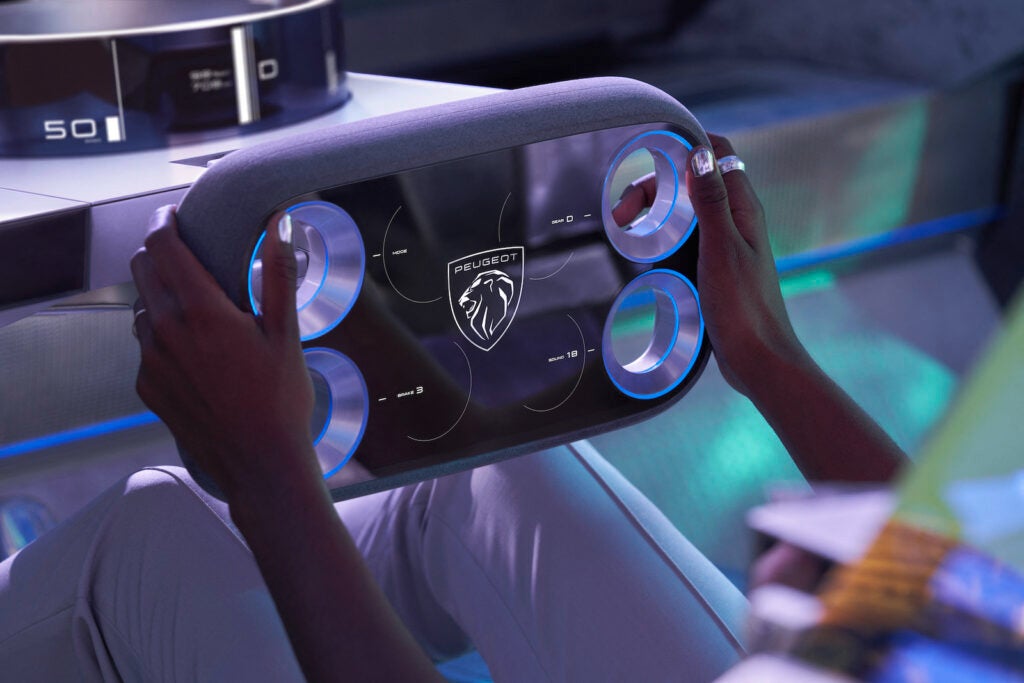
Taken together with the Inception’s planned Level 4 autonomous driving capabilities, and you have a comfortable cabin with the occupants sitting in the classic NASA zero-gravity neutral posture. It’s a natural for getting some rest while you travel.
How do you drive it?
Much of the technology story of the Inception concerns digital controls replacing mechanical apparatus. The Inception makes use of the i-Cockpit technology currently in use by Peugeot cars and the Stellantis STLA Smart Cockpit technology platform, but the idea is to take that development much further.
“We are going to simplify the driving gestures and reinvent the driving experience,” Micheron said.
For example, the concept features Steer-by-Wire replacing the traditional steering wheel with a “Hypersquare” digital controller. The Hypersquare is a screen with circular recessed cells in each of its four corners. Peugeot describes this as “a tablet-type screen dedicated to the distribution of control information.
The pictograms for the different features (air conditioning, radio volume, ADAS, etc.) are displayed on the two side panels to facilitate access to the chosen control by moving the thumb only, without taking your hands off the steering control.”
Peugeot has also done away with a traditional dashboard and center stack. The minimal Hypersquare cockpit interface will be retracted when autonomous driving is enabled. Then a large panoramic screen slides out from the floor to offer a new passenger compartment experience. Peugeot’s stated goal is to introduce Hypersquare controls on a next-generation vehicle before the end of the decade.
- SEO Powered Content & PR Distribution. Get Amplified Today.
- Platoblockchain. Web3 Metaverse Intelligence. Knowledge Amplified. Access Here.
- Source: https://www.thedetroitbureau.com/2023/01/peugeot-touts-inception-electric-concept-at-ces-2023/
- 2022
- 2023
- a
- About
- access
- According
- adapts
- ADAs
- adjustable
- Adjusted
- ADvantage
- AIR
- Air Conditioning
- All
- ambition
- ambitious
- and
- apparent
- approach
- architecture
- around
- artificial
- artificial intelligence
- aspects
- automakers
- automotive
- autonomous
- back
- bar
- based
- battery
- becoming
- before
- Beginning
- behind
- Beyond
- body
- Brain
- brand
- built
- capabilities
- car
- carbon
- carbon footprint
- cars
- Cells
- Center
- ceo
- certain
- Ces
- changing
- charge
- charging
- chosen
- Close
- closely
- Cockpit
- combined
- combining
- comfort
- comfortable
- committed
- Communications
- company
- concept
- Concerns
- Configuration
- connected
- consumer
- Consumer electronics
- Consumers
- continued
- control
- controller
- controls
- Core
- corners
- Corporate
- Currently
- Customers
- dashboard
- decade
- dedicated
- Design
- designers
- designs
- Development
- different
- digital
- Director
- discussions
- Display
- displays
- distribution
- doors
- drive
- driver
- driving
- each
- Electric
- Electronics
- enabled
- enables
- energy
- energy use
- enjoy
- enriching
- equipped
- Era
- etc
- Europe
- EV
- example
- Excellence
- experience
- Experiences
- facilitate
- Feature
- Features
- Find
- firmly
- First
- Floor
- Flowing
- Footprint
- from
- front
- full
- fully
- further
- future
- generation
- getting
- gives
- goal
- Goes
- going
- Hands
- height
- Highlight
- highlights
- Hit
- HP
- HTTPS
- human
- idea
- immersive
- in
- inception
- inches
- includes
- Including
- industry
- information
- Intelligence
- Intelligent
- interaction
- interactive
- Interface
- interior
- introduce
- IT
- Jackson
- Key
- large
- Las Vegas
- Last
- launched
- leading
- Led
- Length
- Level
- level 4
- Life
- live
- Look
- maintains
- make
- MAKES
- Making
- Market
- Marketing
- max-width
- mechanical
- messages
- minimal
- models
- more
- Motor
- Motors
- moving
- Natural
- Neutral
- New
- next
- next-generation
- Notes
- objective
- october
- offer
- offered
- Offers
- ONE
- online
- Optimistic
- outside
- overall
- panels
- paris
- part
- PHIL
- phone
- physical
- planned
- platform
- Platforms
- plato
- Plato Data Intelligence
- PlatoData
- plus
- positions
- possibilities
- possible
- power
- Product
- Production
- Products
- Profile
- radical
- Radio
- range
- recognize
- reducing
- release
- remains
- REST
- reveal
- Said
- scheduled
- Screen
- seamless
- seconds
- Services
- set
- settings
- Shape
- shift
- show
- shown
- Simple
- simplify
- Sitting
- Size
- Slides
- smart
- Software
- some
- Spatial
- specified
- stack
- standard
- Starting
- stated
- steering wheel
- Story
- structure
- support
- system
- Take
- taking
- Technology
- The
- The Future
- their
- Thinking
- to
- today
- together
- toward
- traditional
- Transformation
- travel
- Trend
- unveiled
- unveiling
- use
- Values
- VEGAS
- vehicle
- Vehicles
- Virtual
- vision
- volume
- week
- welcome
- Wheel
- which
- while
- Wikipedia
- will
- wireless
- without
- years
- Your
- youtube
- zephyrnet

